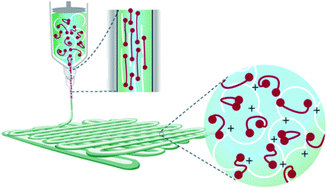Development and characterisation of a new bioink for additive tissue manufacturing†
Abstract
Additive manufacturing forms a potential route towards economically viable production of cellular constructs for tissue engineering. Hydrogels are a suitable class of materials for cell delivery and 3D culture, but are generally unsuitable as construction materials. Gelatine-methacrylamide is an example of such a hydrogel system widely used in the field of tissue engineering, e.g. for cartilage and cardiovascular applications. Here we show that by the addition of gellan gum to gelatine-methacrylamide and tailoring salt concentrations, rheological properties such as pseudo-plasticity and yield stress can be optimised towards gel dispensing for additive manufacturing processes. In the hydrogel formulation, salt is partly substituted by mannose to obtain isotonicity and prevent a reduction in cell viability. With this, the potential of this new bioink for additive tissue manufacturing purposes is demonstrated.


 Please wait while we load your content...
Please wait while we load your content...